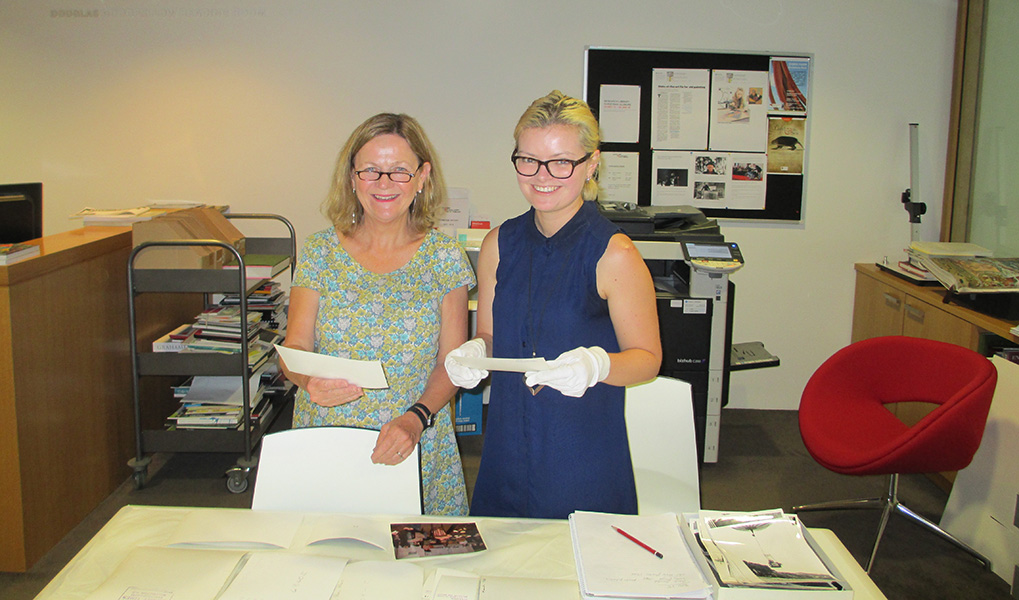Friday 29 January 2016
Kiki Lawler-Dormer, E H McCormick Research Library Summer Intern
Article Detail

Caroline McBride (Librarian/Archivist) and Kiki Lawler-Dormer (Intern) accessioning the John B. Turner Archive
This year I was very lucky to be granted the 2015/2016 Summer Art Archives internship with the E H McCormick Research Library at Auckland Art Gallery; an opportunity that was met with excitement and an eagerness to learn. Currently studying conservation at the University of Melbourne, I have become increasingly interested in the other areas within the cultural heritage sector where conservation techniques are being applied. This is apparent in archiving when rehousing and assessing an archive before and during acquisition.
The archive selected for this internship was John B. Turner’s archive. John B. Turner (b.1943) is a prolific critic, researcher, photographer and collector in and of NZ photography. A mentor and driving force behind NZ photography Turner started lecturing at Elam School of Art in 1971 and along with a select few launched PhotoForum in 1973. Turner appears to have started collecting material since 1965, when he was a press photographer in Wellington with items dating from 1897–2009.
Armed with Turner’s original finding aids (a fabric bound green folder and a sheet of paper from January 14th 1989), Caroline McBride (Archivist/Librarian) and I headed to the storage facility to form a plan of attack. Choosing to focus on the NZ photographer section of the archive, Caroline and I had our work cut out for us.
The NZ photographer archive (an A–Z of information files) was initially housed predominantly in manila folders inside filling cabinets. In addition to photo boxes, slide boxes and the occasional banana box, this section of the archive was easily accessible in amongst the intimidating amount of content included in the overall archive.
To house the files it was decided that the material should be stored in paper folders, envelopes, and storage boxes that were acid free, lignin-free and had a neutral pH. Delicate items were placed in Mylar sleeves or acid free conservation grade tissue paper. Due to the sheer size of the archive and time restraints we did not reorder the material in each of the files by date, something that may have occurred if it were a smaller archive. Secondly because of the location of the archive only the staples showing signs of rust were removed, otherwise they were left in the documents as the archive is now being housed in a controlled area and any further degradation is unlikely to occur. Each artist file was separated from the next using carbon neutral standard copying A3 paper, typically not considered conservation grade paper stock subsequently it may need to be addressed at a later date, however because of the controlled storage conditions the paper is expected to remain stable.
The majority of John B. Turner’s archive on NZ photographers consists of paper documents. This section of the archive consists of artist files which, as well as original material, include media clippings, correspondence, exhibition ephemera, research notes, references for others, student work, publications and photographic reproductions, prints and transparencies.
It is hugely satisfying to know at the end of the 100-hour internship we managed to complete the NZ photographer section of John B. Turner’s archive. Accessioning 6.59 linear meters consisting of approximately 680 artist files, 5 boxes of slides, 760 photographs and prints and over 150 posters and postcards. This section of the John B. Turner archive is an invaluable resource for the New Zealand art sector.
In conclusion the internship with Caroline at the E H McCormick Research Library has been an invaluable experience. Camilla Baskcomb (Works on Paper Conservator), Annette McKone (Objects Conservator) Tom Irwin, Catherine Hammond and Caroline have been amazing teachers, colleagues and I couldn't have asked for a better team to have spent my last two and a half weeks with. I will without a doubt miss them all and the E H McCormick Research Library.